Finding Time to Collect
By John M. Hotchner
 Busy! Busy! Busy! That is what we all seem to be; running from commitment to commitment, keeping up with family, keeping up with current events in this election year so we can be responsible voters, paying attention to the grass, the roof, the siding, taking out the garbage, and a thousand other things that seem to rate high on the Must Do list.
Busy! Busy! Busy! That is what we all seem to be; running from commitment to commitment, keeping up with family, keeping up with current events in this election year so we can be responsible voters, paying attention to the grass, the roof, the siding, taking out the garbage, and a thousand other things that seem to rate high on the Must Do list.
I think one of the things getting in the way of stamp collecting these days is the multiplicity of things to do (including 900 TV channels, the iPhone, the time required for exercise, etc.); much of which were not there to tempt us 50-and-more years ago when stamp collecting was in its heyday; before its share of the population began to decline. Oh yes, and don’t let me forget the increased responsibilities we have when both spouses work, with the need to apportion household chores in ways that were not an issue when my father brought in the bucks, and my mother took care of the kids and the house.
It is a different world; and in many ways a better and more satisfying one despite the more hectic pace we keep up. As a retiree, I thought I would spend my days at leisure, but I seem to be busier than ever. I’m told that this is not an unusual situation.
So, given that it is difficult to shoehorn into the day discretionary activities like stamp collecting, how to find (or make) time to work on our collections? Many people I have known have said at one time or another that they ‘don’t have time to do such-and-such.’
It may be true for them, but it is a phrase I never use. I prefer to think of that problem in terms of making time to do the things I really want to do. If I can’t, then I don’t want to do them badly enough! What follows is my sharing of how I fit stamp collecting into my day.
I have to start off this little essay by owning up to the fact that I do not own the revealed truth. I have some ways that I find time, but recognize that they may not work for you. And there may be others I could benefit from, and I am looking forward to hearing from readers with your hints about how you find time. I will share these in a future column.
My primary ‘trick’ is to treat household chores as the first priority. While that might seem counterintuitive, the division of labor in our house is clear, and the things I am supposed to do get done with a minimum of fuss. Getting them done to my wife’s satisfaction leaves me in charge of the time that is left. And I can devote it to collecting activities without recrimination or guilt.
Secondly, I prioritize my collecting activities at a high level so that it is both normal and natural for me to spend some time every day working on my collection; doing the never-ending tasks that are needed to organize; to keep the collection from taking over first closets, then the dining room table, then the whole house.
Contrary to scientific studies that say multitasking is bad practice, even unhealthy, I’ve been doing it for 60 years, and it works for me. I can’t just watch TV, or talk on the phone, or stand in a line. These are opportunities to catch up on philatelic reading, outline articles, sort, catalog, answer mail.
In truth, there are some creative things like actually writing the articles and designing exhibit pages that need full attention, but it is surprising how much can be done with other lighter activities.
Another helpful practice is my penchant for the evening nap. Conking out for 90 minutes after dinner allows me to work uninterrupted and fairly fresh, into the wee hours. At that time there are no interruptions, and it is not unusual that I lose track of time.
Even when I had a day job, this allowed me “stamp collection time” for a couple of hours each evening.
Another element is motivation. When what I did was all up to me, there was not much motivation to get on with it. Then I began joining clubs and societies and getting involved in their projects and specialties. Suddenly, there was more reading to keep up with, more interesting specialty areas to dig into, more things to look for on my stamps, and on the other end of the equation, more people interested in what I was doing; sometimes even waiting for the results of my activities; as in hoping for trading material to be available, or the results of my research.
In my job, I traveled — a lot; up to a third of the time. This gave me all sorts of opportunities. My ‘airplane reading’ file provided enjoyment on long flights. Evenings while others might be out for lavish dining or other night-time activities, I more often sat in my hotel room working on a project; be it washing, bringing an album current, checking with magnifier in hand for plate varieties, doing sales book pages, or whatever needed to be done. Not only did I save a lot of money — money that could be available for philatelic purchases — I kept off extra pounds, arrived for work the next day refreshed, and I had a sense of accomplishment to boot.
These days I travel to see grandchildren and for the occasional stamp show. Stamp projects are always part of my packing. I am hopeful that the grandchildren pick up more than a little of my enthusiasm for collecting; and not just a sense that grandpa is obsessed with little bits of paper. Some have given it a try, but gone on to other things. Others show little interest beyond asking what I am doing. But even there, I like to think I am sowing seeds.
My own four children got into the hobby to the point of exhibiting, but moved on. One is a certified collector — but of sports cards! Perhaps the longer term benefit to them was simply seeing me enjoying my philatelic work, day-in and day-out. (All of them spent some time in my “real” office also.) Each of them has an excellent work ethic, and I would like to think that part of their development was internalizing what they saw as my enjoyment in my work; though it is hard to think of my philatelic endeavors as “work” in the usually-accepted sense.
Which leads me to talk a little bit about the benefits of working on your stamp collection. Getting done what you get done is its own reward, but there are hidden benefits as well. Getting into your project of the day mostly banishes your other cares; some of which can be heavy burdens about which you can do little but try to live through. With stamps, you are able to organize that corner of your world in a pleasing way. So, you gain relaxation, stress reduction, exercise your organizing skills, and some level of control over a largely uncontrollable world.
Some people take pills to achieve those goals. Not my path!
So, it is the wise person who finds in hobbies a more natural method of stress management. Whether philately, sports cards, coins, comic books, or whatever else floats your boat, it is good to put some effort into establishing goals and working toward them.
Should you wish to comment on this column, or have questions or ideas you would like to have explored in a future column, please write to John Hotchner, VSC Contributor, P.O. Box 1125, Falls Church, VA 22041-0125, or email, putting “VSC” in the subject line.
Or comment right here.

 The
The 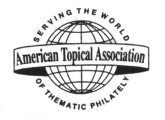 The latest issue of the American Topical Association’s website feature, Topical Tidbits, brings its total pages to more than 300—all available free online. The colorful pages of the new issue of Topical Tidbits take philatelists of all ages south of the border to Mexico, with facts, games, puzzles and lots of stamp images about our southern neighbor.
The latest issue of the American Topical Association’s website feature, Topical Tidbits, brings its total pages to more than 300—all available free online. The colorful pages of the new issue of Topical Tidbits take philatelists of all ages south of the border to Mexico, with facts, games, puzzles and lots of stamp images about our southern neighbor.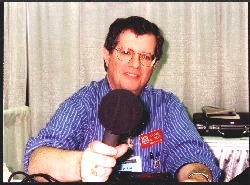 The pieces were always written for a mass audience, not stamp collectors, and rarely used philatelic jargon. In fact, they rarely used “philatelic” — making it hard to talk about the bigest stamp collecting organization in the U.S., the American PHILATELIC Society! It was kept to one minute, so that commercial radio stations would run it.
The pieces were always written for a mass audience, not stamp collectors, and rarely used philatelic jargon. In fact, they rarely used “philatelic” — making it hard to talk about the bigest stamp collecting organization in the U.S., the American PHILATELIC Society! It was kept to one minute, so that commercial radio stations would run it.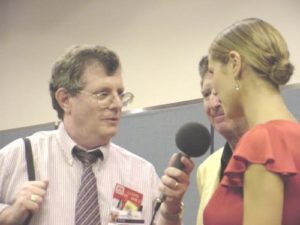
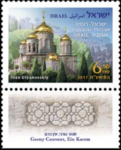 The magnificent gold –domed Russian church named the
The magnificent gold –domed Russian church named the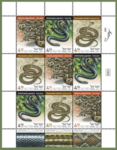 Some people scream and others have them as pets but
Some people scream and others have them as pets but  Submarines
Submarines Today, when you visit one of the
Today, when you visit one of the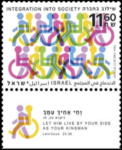 Israel recognizes the importance of
Israel recognizes the importance of 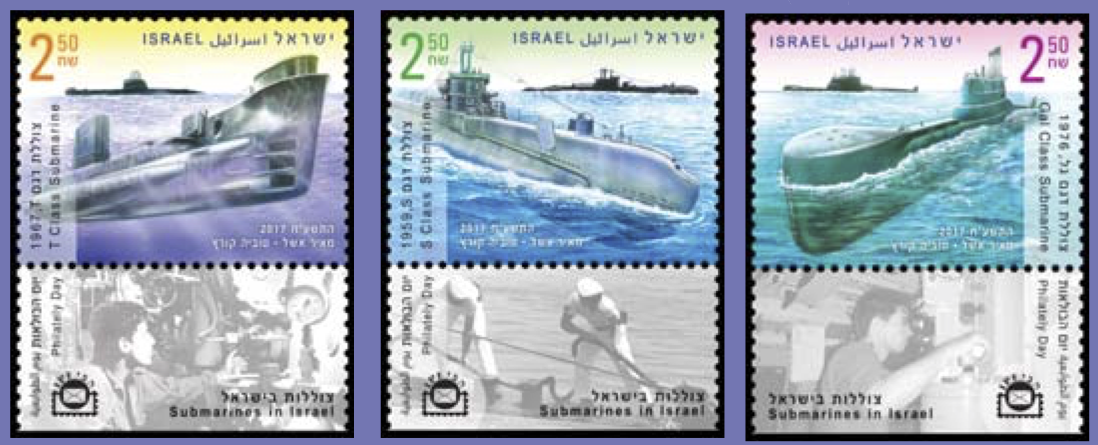 The Israeli Navy did not have any submarines when it was founded in March 1948. The thought of acquiring and operating submarines did not ripen until a few years later. It was a bold and innovative step for the teams slated to operate these submarines as well as the technical personnel who would maintain them. Submarine personnel are selected meticulously, as they must be extremely level-headed and professional, and beyond all else must be able to work and live as a team.
The Israeli Navy did not have any submarines when it was founded in March 1948. The thought of acquiring and operating submarines did not ripen until a few years later. It was a bold and innovative step for the teams slated to operate these submarines as well as the technical personnel who would maintain them. Submarine personnel are selected meticulously, as they must be extremely level-headed and professional, and beyond all else must be able to work and live as a team.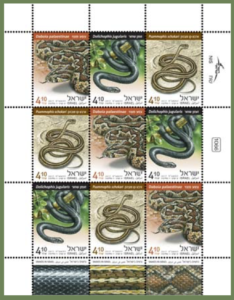 Israel is home to many different reptile species thanks to its location at the meeting point of three different continents and the wealth of habitats it provides. Some 100 reptile species make their homes here, among them approximately 40 species of snakes, nine of which are venomous.
Israel is home to many different reptile species thanks to its location at the meeting point of three different continents and the wealth of habitats it provides. Some 100 reptile species make their homes here, among them approximately 40 species of snakes, nine of which are venomous.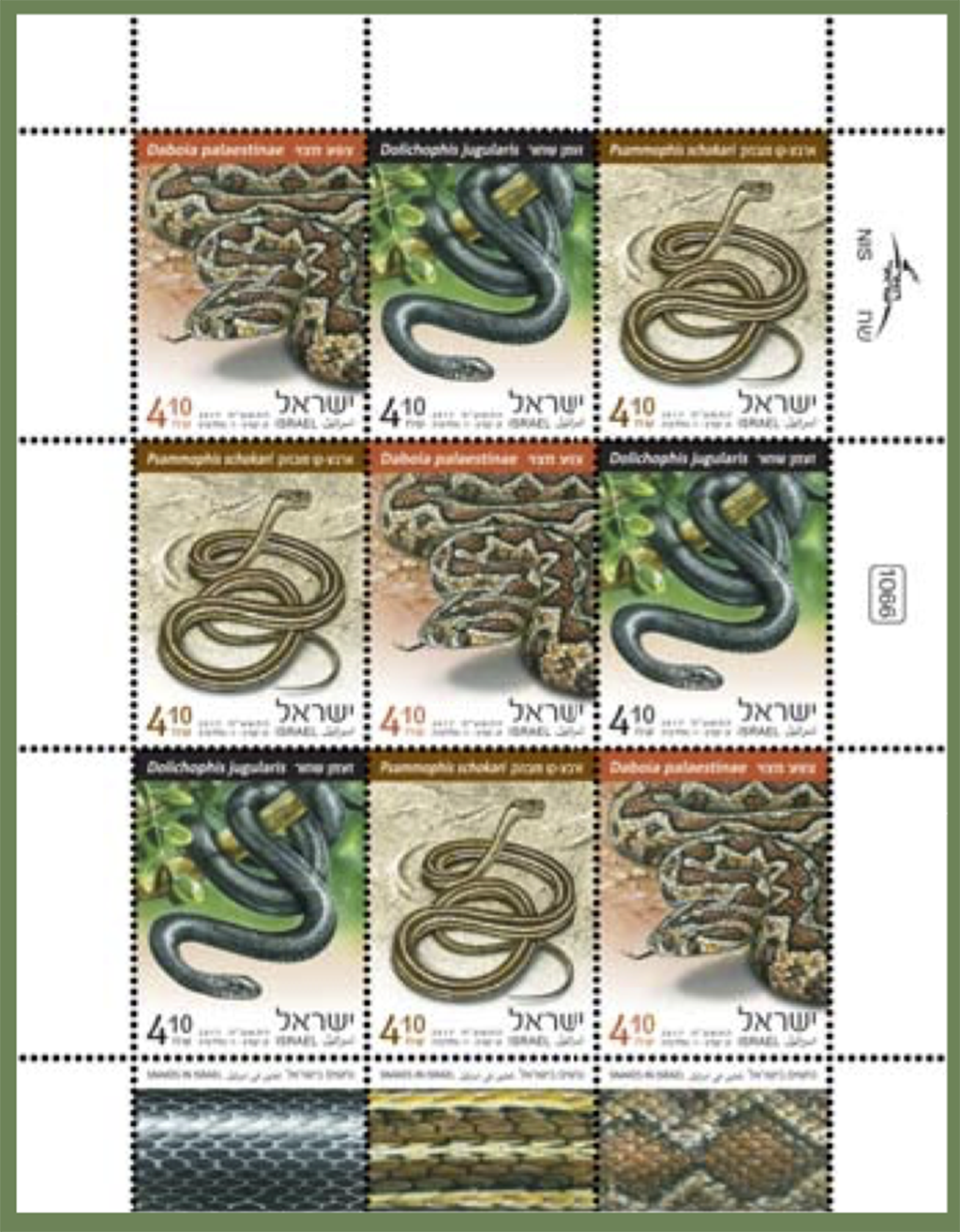

 From Israel Post. This stamp will be issued December 19, 2017.
From Israel Post. This stamp will be issued December 19, 2017.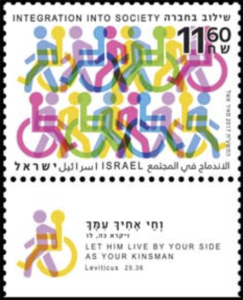 This stamp will be issued December 19, 2017. From Israel Post:
This stamp will be issued December 19, 2017. From Israel Post:

